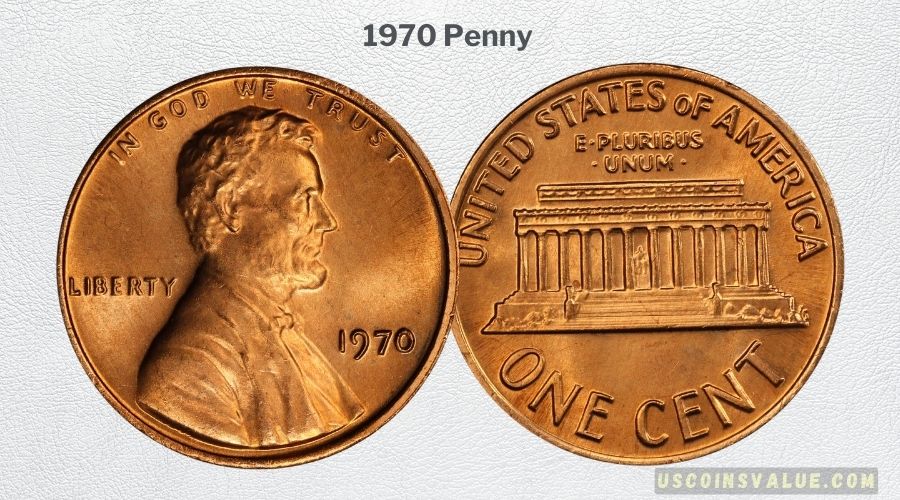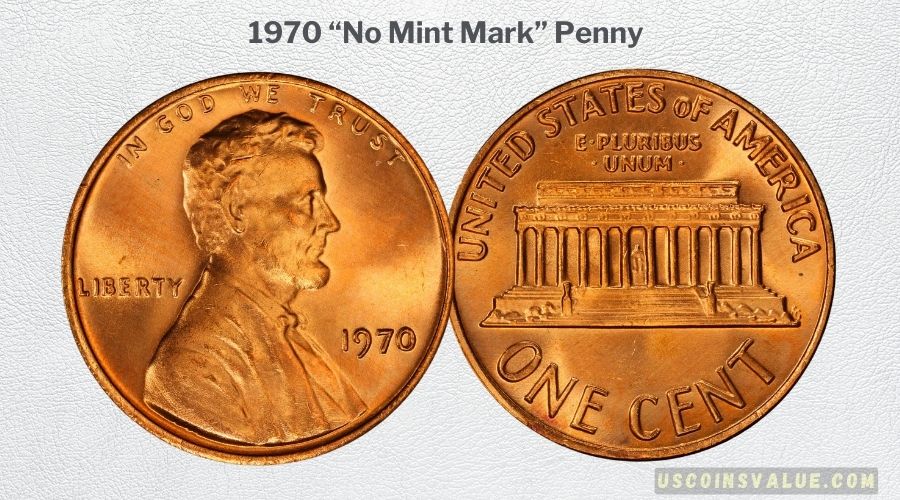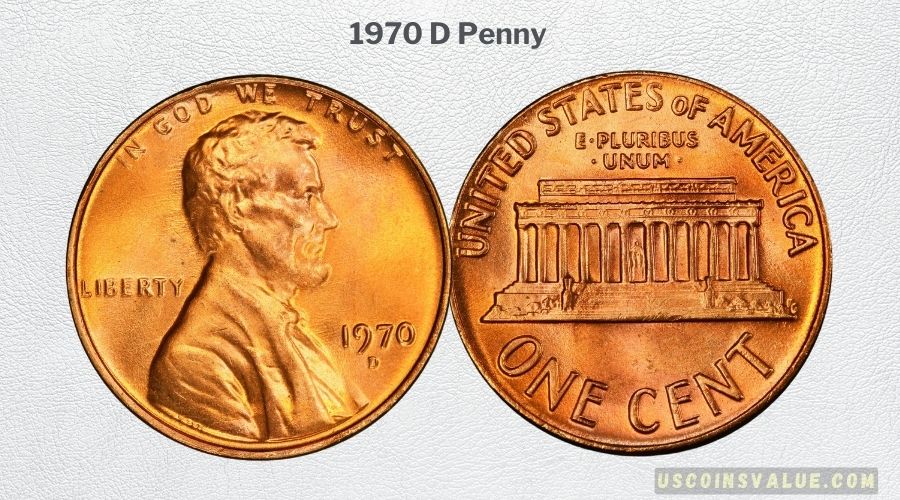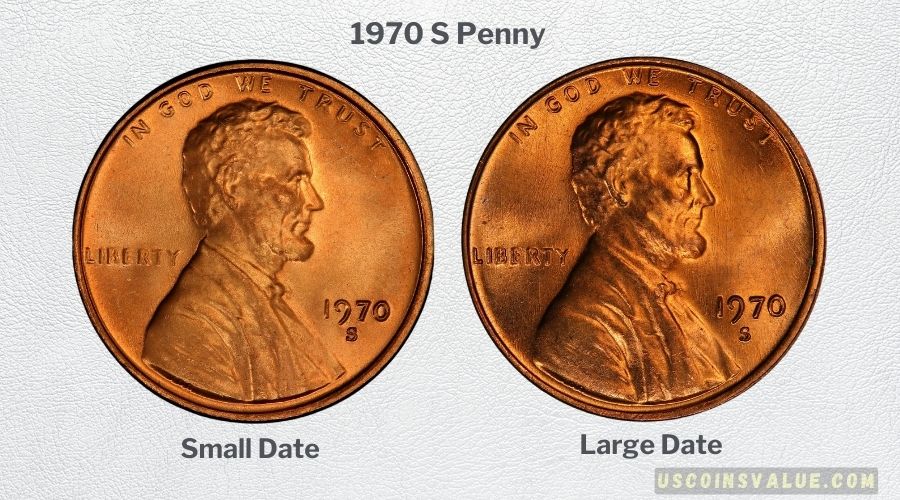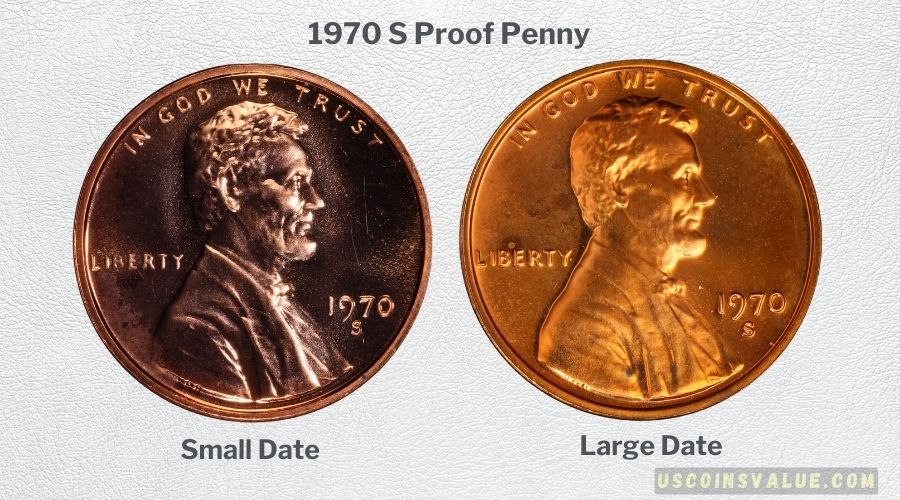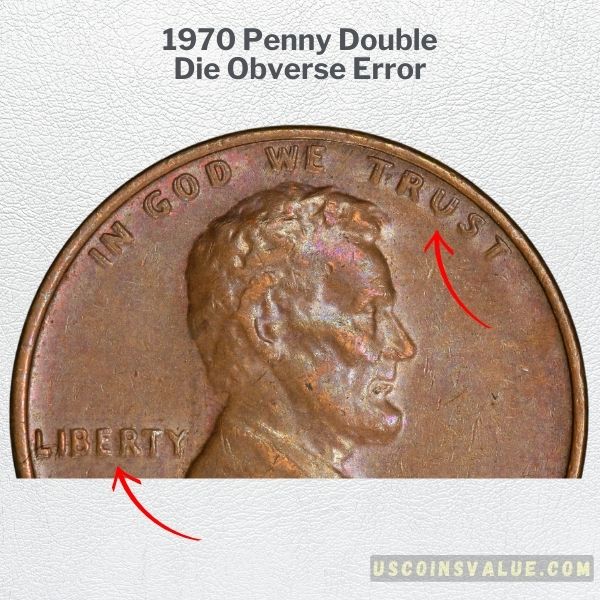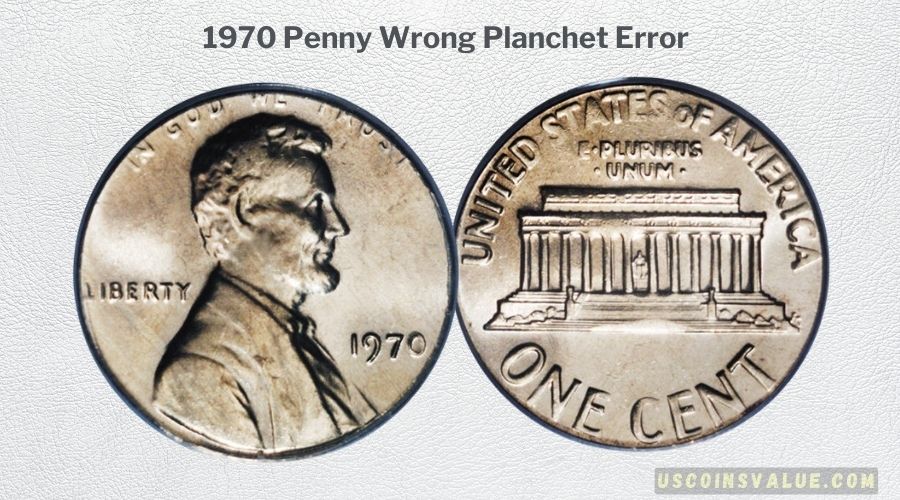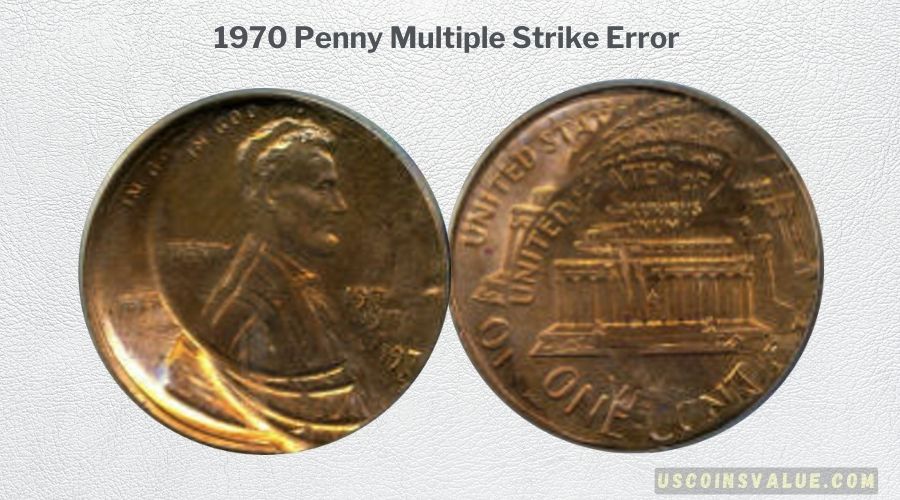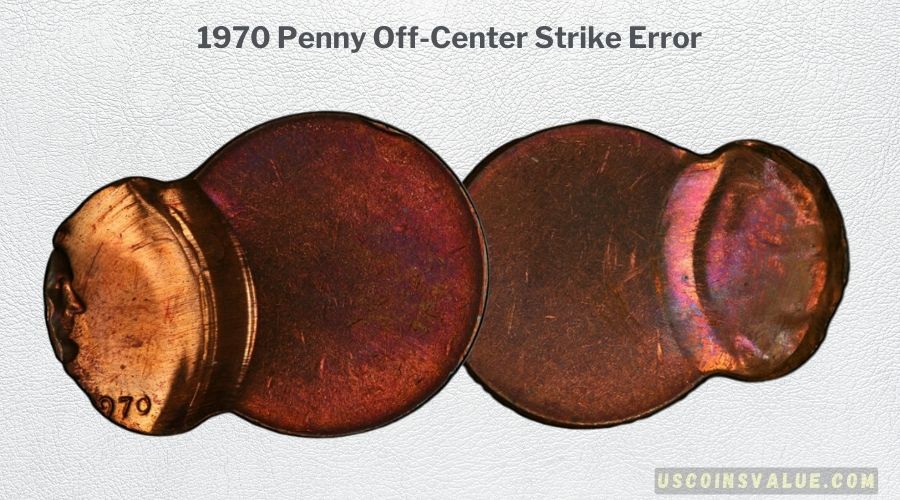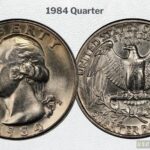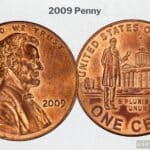Many beginner coin collectors do not know this, but do you know that the 1970 penny comes in four variations?
That’s right, these varieties include the No mint mark penny, the “D” mint mark penny, the regular strike “S” mint mark penny and the proof strike “S” penny all from 1970.
In 2005, a proof 1970-S penny sold for $18,400, making the auction record. Meanwhile, an average 1970 penny will sell for at least $1.16 in Mint State.
What’s the reason for this huge disparity in the sale price of these similar pennies produced in the 1970 you ask and how can you identify one that’s worth big bucks in the coin world? Well, keep reading to find out.
What is the Background of the 1970 Penny?
The 1970 pennies are some of the most unique designs of the modern Lincoln/Memorial series because they have multiple variants including the rare small date errors on the San Francisco-minted coins.
They have the age-old Lincoln head designed by Victor David Brenner engraved on the obverse.
Brenner designed the obverse in 1909 to celebrate the late President’s 100th birthday. His design had a wheat reverse that lasted until 1958. Frank Gasparro redesigned the reverse with an engraving of Lincoln’s Memorial for the new 1959 pennies.
The modern Lincoln Memorial obverse and reverse is still the trending design in the US, and it includes the 1970 one cent.
The 1970 Penny Features
- Series: Lincoln Memorial
- Year of Make: 1970
- Mintage: 1,898,315,000 | 2,891,438,900 | 693,192,814 | 2,632,810 (Proof)
- Mint Branch: Philadelphia, Denver, San Francisco
- Composition: 95% Copper and 5% Zinc
- Weight: 3.11g
- Diameter: 19 mm
- Edge: Plain
Obverse & Reverse Design
The 1970 penny, as part of the modern Lincoln Memorial series, has an image of Abraham Lincoln on the obverse and his memorial building on the reverse.
The obverse has three important details including:
- LIBERTY
- IN GOD WE TRUST
- Year: 1970
Pennies minted in Denver and San Francisco came with mint marks beneath the mintage year.
- Mint Mark: None, “S”, and “D”.
On the reverse there’s a bold engraving of the Lincoln Memorial at the center with Gasparro’s initials “FG” on the bottom right corner of the foundation. Other details include:
- UNITED STATES oF AMERICA
- PLURIBUS.UNUM.
- ONE CENT
What are the 1970 Penny Varieties?
The 1970 penny is famous for its multiple varieties. Some of them came with mint marks to signify the mint facility responsible for their production. Those are the 1970-D and 1970-S pennies in regular strike.
N.B: In addition to the regular 1970-S pennies, the San Francisco mint exclusively minted proof strike 1970-S pennies
| 1970 (Lincoln Memorial) Varieties | Mint Location | Mintage |
| “No Mint Mark” Regular Strike | Philadelphia | 1,898,315,000 |
| 1970-D Regular Strike | Denver | 2,891,438,900 |
| 1970-S (Small & Large Date) Regular Strike | San Francisco | 693,192,814 |
| 1970-S (Small & Large Date) Proof | San Francisco | 2,632,810 |
1. 1970 “No Mint Mark” Penny
1970 pennies from the Philadelphia mint have no mint mark. That’s because, as the first and primary minting facility in the US, there wasn’t a need to brand Philadelphia-minted coins.
The “no mint mark” 1970 pennies had three colors, red, red-brown, and brown.
2. 1970-D Penny
Coins from the Denver Mint had the “D” mint mark at the bottom of the date on the coin’s obverse. They came in three standard colors, red, red-brown, and brown and were all regular strike pennies.
3. 1970-S Regular Strike Penny
The San Francisco Mint had two varieties of regular strike pennies that you can only identify by the date. You’ll need a magnifying glass to see the difference in style of the engraving. The large date variant shows all the digits in the date as equal sizes.
N.B: A few 1970-S pennies came with a smaller “9” in the date.
It’s considered small because the tail is curved, unlike the normal large date variant with the longer tail. 1970-S regular strike pennies with a small date are also rarer and more valuable.
4. 1970-S Proof Penny
Proof pennies are shinier and more beautiful because they came from the first batch of dies. They had the fewest mintage because they were made as sample pieces for regular strike coins.
Like the regular strike 1970 pennies minted in San Francisco, proof 1970-S pennies have two variants — Small and Large Date. Proof coins with contrasting details and fields are graded CAM or DCAM for Cameo and Deep Cameo.
What’s the Current Value of the 1970 Penny?
All 1970 pennies are valuable, but some are worth more money than others. Firstly, you must understand that your one cent will only be worth more than its face value if it’s of quality grade.
Uncirculated regular strike pennies have the highest grade of Mint State, while proof pennies have PR. Typically, the priciest grades are between 60 – 70. With the 1970 pennies, however, only the San Francisco proof coins are worth money from 60 – 70.
For the “no mint mark” penny, only MS63 – MS67 pennies have trade value. With the 1970-D variant, you’ll need MS62 – MS67, while the regular strike 1970-S pennies have value from MS60 – MS67.
| 1970 Penny (MS/PR) | 1970-P (No Mint Mark) | 1970-D | 1970-S Regular Strike (Small & Large Date) | 1970-S Proof (Small & Large Date) |
| 60 | – | – | $6 – $22 | $2 – $4 |
| 61 | – | – | $8 – $25 | $3 – $5 |
| 62 | – | $7 – $8 | $10 – $34 | $4 – $6 |
| 63 | $8 – $9 | $10 – $12 | $16 – $60 | $7 – $65 |
| 64 | $12 – $14 | $16 – $18 | $20 – $70 | $7 – $85 |
| 65 | $18 – $20 | $22 – $26 | $27 – $100 | $8 – $110 |
| 66 | $28 – $65 | $37 – $90 | $75 – $250 | $10 – $165 |
| 67 | $190 – $5,500 | $500 – $3,500 | $700 | $12 – $325 |
| 68 | – | – | – | $14 – $2,600 |
| 69 | – | – | – | $35 – $9,500 |
| 70 | – | – | – | $1,850 |
1. 1970 Penny (No Mint Mark)
The auction record for the “no mint mark” 1970 penny stands at $4,406.25 by Heritage Auctions in 2014. The coin was a high-grade MS67+ piece, which is a rare find even today.
This year, a “no mint mark” 1970 pennies sold for as low as $13 in January for an MS63 RB grade. You can start a new collection with as low as $2 – $9 if you buy your 1970 “no mint mark” from eBay. But you’ll spend over $100 for pieces in higher MS grades.
In 2023, an MS67 RD piece sold for $180 but auctioned for less value at $159 in Nov. 2022. The 1970 “no mint mark” penny hasn’t auctioned for five figures since 2014, and before that, 2005.
See this table for the highest auction prices of this variant.
| Grade | Highest Price & Sale Date | Firm |
| MS67+ | $4,406.25 (2014) | Heritage Auctions |
| MS67 | $1,265 (2005) | Heritage Auctions |
| MS66 | $748 (2005) | Heritage Auctions |
| MS67 | $690 (2011) | Heritage Auctions |
| MS67 | $546 (2008) | Heritage Auctions |
2. 1970-D Regular Strike Penny
It’s been 7 years since the highest sale of a 1970-D penny. Heritage Auctions sold an MS67+ RD grade for $2,820. The firm also sold an MS67 for $1,116 that year, and it was the last five-figure sale.
In 2023, 1970-D pennies have had the lowest sales of all the variants. In Sept., eBay sold some MS64 pieces for $2 – $15. Apr. saw one of the highest sales in a while for an MS67 RD piece at $336. It was more than the $250 realized in Mar. during an eBay sale.
The late 2010s saw some high sales, too, from $800 to $1100. See the highest sales ever for a regular strike 1970-D penny.
| Grade | Highest Price & Sale Date | Firm |
| MS67+ RD | $2,820 (2016) | Heritage Auctions |
| MS67 | $1,955 (2007) | Heritage Auctions |
| MS67 | $1,495 (2008) | Heritage Auctions |
| MS67 | $1,380 (2008) | David Lawrence RC |
| MS67 | $1,149 (2014) | eBay |
3. 1970-S (Large & Small Date) Regular Strike Penny
Small Date MS62 by Heritage Auctions in 2003 for $1,380 and MS63 in 2001 for $1,150.
Heritage Auctions sold an MS67 RD grade with a small date for $1,500 in 2023. A lower MS66 RD grade sold for less than half at $480 also in Apr., while David Lawrence sold a similar piece for $150 in Jan.
In 2007, Heritage Auctions sold an MS67 1970-S regular strike penny with a large date for $1,495.
A large date variant in grade AU58 BN sold for $1,000 on eBay in 2020. Bowers & Merena sold an MS67 for $1,380 in 2010, and Heritage Auctions sold a similar graded piece for $1,093 two years prior.
| Grade | Highest Price & Sale Date | Firm |
| MS67 (Small Date) | $2,464 (2008) | David Lawrence RC |
| MS67 RD (Small Date) | $2,310 (2018) | Legend Rare Coin Auctions |
| MS67 (Small Date) | $2,070 (2007) | Bowers & Merena |
| AU50 (Small Date) | $1,610 (2005) | Heritage Auctions |
| MS67+ RD (Large Date) | $1,500 (2019) | eBay |
| MS67 (Large Date) | $1,410 (2013) | Heritage Auctions |
4. 1970-S Proof (Large & Small Date) Penny
The 1970-S Proof penny has two sub-variants with different values because of their uniqueness. Although the Small date version is more valuable, the large date 1970-S proof penny has an auction record of $3,220 from 2002.
In 2023, a PR69 RD piece auctioned for $1,140 at Heritage Auctions. Other auctions this year realized less value, including a $149 PR67 RB piece in Jan. and a similar grade auctioned for $47 in Apr. But another PR69 RD piece sold for $276 at the firm also in Apr.
The higher-valued small date 1970-S proof penny has a whopping auction record of $18,400 from 2005. Other high prices for this variant include $4,600 for a PR68 piece in 2003, $3,738 in 2010 for PR69 grades, and $3,335 in 2005.
1970-S proof pennies with small dates saw high prices at auction this year. Heritage Auctions sold a PR68 RD grade for $134 in May and a PR68 CAM piece for $228 in Apr. In 2023, eBay sold a PR69 RD grade for $328, $600 in Apr.
You can buy the large and small date variants for as low as $10 from eBay. Check out the highest prices ever here:
| Grade | Highest Price & Sale Date | Firm |
| PR69 (Small Date) | $18,400 (2005) | Heritage Auctions |
| PR69 DC (Small Date) | $8,225 (2016) | Heritage Auctions |
| PR69 DCAM (Small Date) | $6,600 (2020) | Stack’s Bowers |
| PR69 (Small Date) | $4,994 (2013) | Heritage Auctions |
| PR69 (Large Date) | $3,220 (2002) | Heritage Auctions |
| PR70 (Large Date) | $2,530 (2003) | Heritage Auctions |
1970 Penny Error List
Although every penny has standard features, you’ll be surprised at how many of them exist with errors. Don’t let that stop you from collecting a coin because sometimes, the mistakes make it more desirable.
The 1970 pennies are some of the most popular series with errors, including the date errors from the San Francisco Mint. Other common mistakes you’ll find are:
- Double Die Obverse Error
- Wrong Planchet Error
- Multiple Strike Error
- Off-Center Strike Error
1. Double Die Obverse Error
When the engravings don’t appear vividly on the first die application, there’ll be a repeat of the process. The second application thickens the engravings and makes the details appear doubled. It can be on the obverse or reverse, depending on the side with the faint die.
The 1970-S regular strike penny had many coins with the Double Die Obverse error. There were so many that some collectors categorized them as a separate variant.
Numismatic expert Ron Guth says the most valuable 1970-S coins with DDO error have large dates and are tagged FS-101 and FS-103. Per Jaime Hernandez, another expert, this variant is one of the rarest because of its “dramatic DDO” error on IN GOD WE TRUST and Liberty.
- In 2001, Bowers & Merena sold an MS66 grade 1970-S penny with the DDO error for $24,150.
- David Lawrence RC sold an MS65 grade in color RB for $9,500 in 2018.
- A 1970-S DDO penny with a large date sold for $6,600 in 2022.
- An independent eBay seller made $3,675 on an MS64 grade in 2013.
2. Wrong Planchet Error
The plain surface that a strike hits to form a coin is called a planchet. Every denomination has a defined planchet with a standard weight, diameter, and die to create uniform coins.
Sometimes, an operator may feed the wrong planchet into the minting press, causing the coin to come out with odd features. A prime example is a Lincoln cent struck on a dime planchet.
- In 2006, Heritage Auctions sold a 1970 Lincoln cent struck on a dime planchet for $632.50.
3. Multiple Strike Error
When a planchet shifts because of a loose retaining collar, the engraving strike wouldn’t land well. So a coin would need multiple strikes, sometimes as little as two and other times as much as five, to create defined details.
- In 2004, Heritage Auctions sold a 1970-S Lincoln penny struck five times with a large date for $921.15.
- Earlier that year, a similar piece graded MS64 sold for $690.
4. Off-Center Strike Error
When a coin has a single strike that misses the mark, there’s an off-center strike error. The shift can be so little at 5% or very wide at almost 90%. When the off-center strike is wide, most of the field is left empty, with details on only a portion of the coin.
With narrow off-center strikes, you’ll barely notice the shift. Often, the wider the shift, the more valuable the error becomes.
- A 1970 Lincoln penny with 15% off-center strike sold for $79 in 2021.
- Also in 2021, a 65% off-center strike 1970 Lincoln cent sold for $99.
- An 85% off-center strike 1970 penny graded MS64 sold for $180 in 2021.
Final Thoughts
You’re right to add any 1970 penny to your coin collection. They’re also one of the few whose errors are worth tens to thousands of dollars, depending on the grade. Remember the 1970-S proof variant is the most valuable.
You’re more likely to find a cheap 1970 penny on eBay than a reputable auction firm. But it’s best to patronize the firms for authentic and guaranteed quality coins. Always appraise your 1970 penny before buying or selling to ensure you’re getting the best price.
We hope this guide helps you on your way to becoming a numismatic expert.

